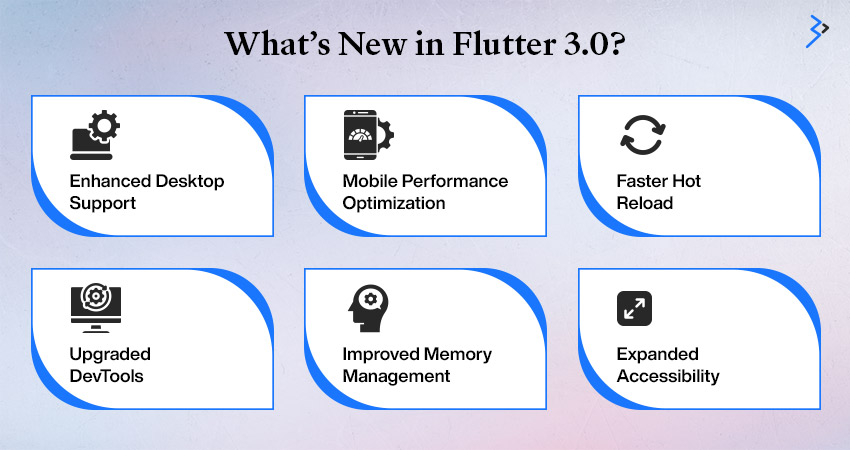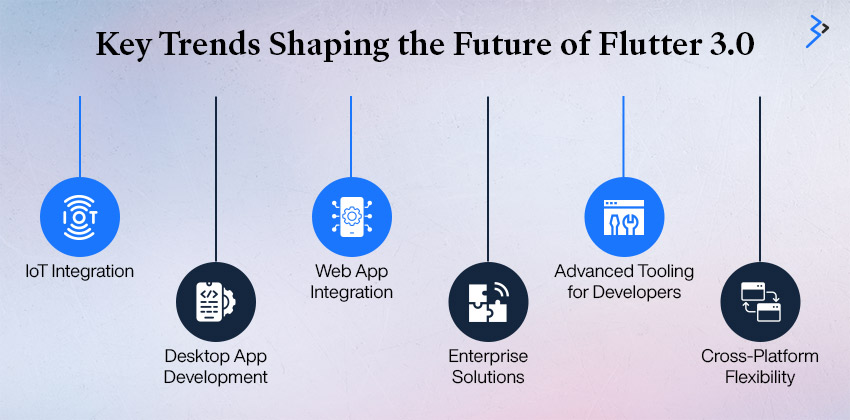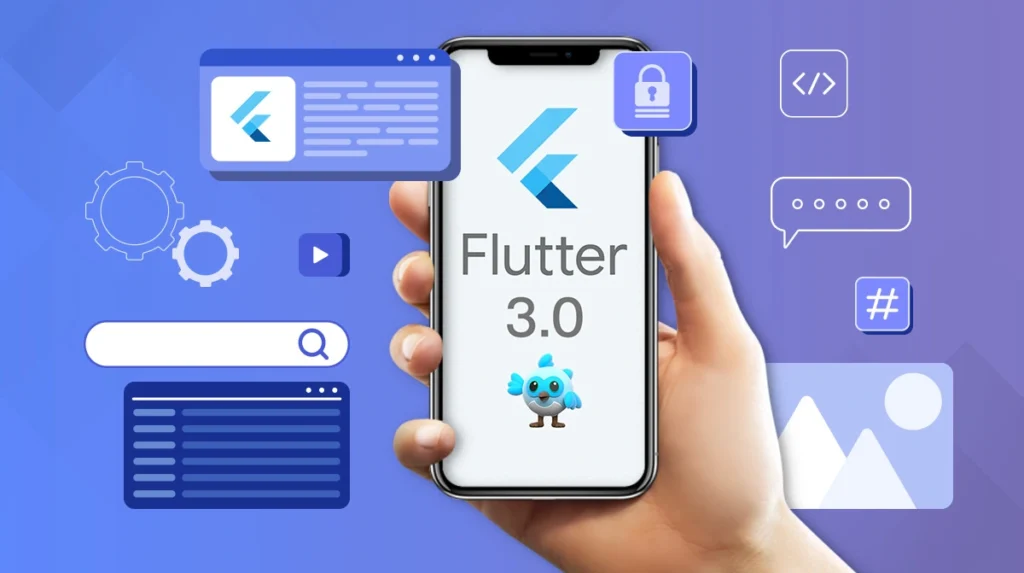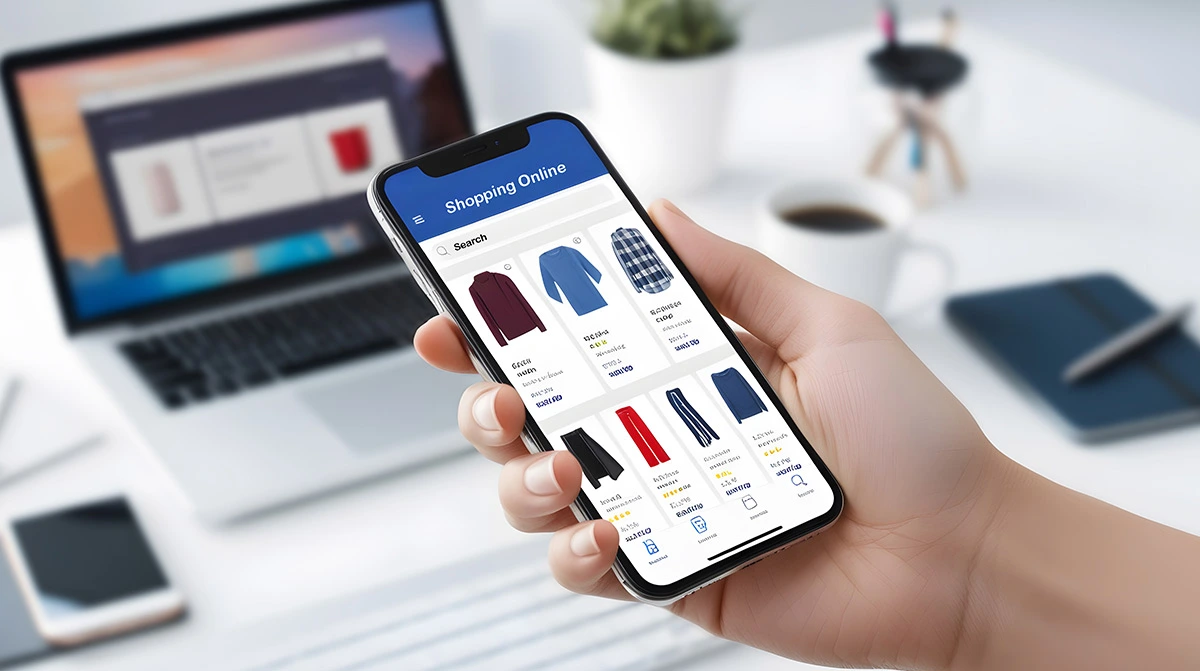Flutter 3.0 represents a milestone in cross-platform development, offering new capabilities and features that simplify app creation for mobile, web, and desktop platforms.
This blog highlights the critical improvements in Flutter 3.0, emerging trends, and its growing influence across industries, showing why it’s becoming a top choice for developers and businesses.
Flutter, developed by Google, has become a leading framework in cross-platform mobile app development. Its latest version, Flutter 3.0, introduces several groundbreaking features designed to transform developers’ creation of apps for multiple platforms.
By delivering enhanced performance and flexibility, Flutter 3.0 significantly elevates cross-platform app development, making delivering high-quality apps more accessible and more efficient.
Flutter’s unique value lies in its ability to use a single codebase for iOS and Android platforms. This accelerates development cycles, reduces costs, and ensures a seamless user experience across devices.
Flutter’s popularity has surged because it enables developers to create high-performing, visually consistent apps while saving time and resources. As more businesses and developers recognize these advantages, Flutter’s presence in the cross-platform development landscape continues to expand.
The Evolution of Flutter: Why It Matters in Cross-Platform Development
Before diving into Flutter 3.0’s key features, it’s essential to understand why Flutter has become a dominant player in cross-platform app development. Unlike other frameworks, Flutter allows developers to write one codebase for multiple platforms—iOS, Android, desktop, and web—drastically reducing time, costs, and complexity. Since its launch, Flutter has rapidly evolved, and version 3.0 takes this journey further by delivering enhanced tools, faster performance, and broader platform support.

Key reasons for Flutter’s growing popularity:
- Single Codebase: Develop apps for multiple platforms with one code, reducing maintenance efforts.
- Consistent UI: Maintain a uniform user experience across devices, regardless of screen size or operating system.
- Speed and Efficiency: Faster time to market due to streamlined workflows and optimized performance.
What’s New in Flutter 3.0?

Flutter 3.0 has innovative features to enhance productivity, performance, and the overall development experience.
- Enhanced Desktop Support: Flutter 3.0 improves Windows and macOS app development, making desktop apps more responsive and easier to manage.
- Mobile Performance Optimization: By precompiling shaders, apps built on Flutter 3.0 run smoother on Android and iOS devices.
- Faster Hot Reload: Developers can now see changes reflected instantly without restarting the entire app.
- Upgraded DevTools: Better debugging, profiling, and monitoring options simplify the development process for more complex applications.
- Improved Memory Management: Reduced CPU usage and optimized memory allocation ensure seamless performance, even for large applications.
- Expanded Accessibility: Flutter 3.0 offers better support for screen readers, enhanced internationalization, and other accessibility features that broaden its global appeal.
These enhancements streamline app creation, making Flutter a more versatile and powerful tool for developers.

Key Trends Shaping the Future of Flutter 3.0
The following trends illustrate how Flutter 3.0 influences various industries and pushes cross-platform development boundaries.
- IoT Integration: Flutter 3.0’s ability to create seamless cross-platform IoT apps is gaining traction. Developers are now empowered to build connected apps across different platforms from smart home devices to wearable technology.
- Desktop App Development: Flutter’s extended support for Windows and macOS means businesses can create high-quality desktop apps, opening up new avenues for cross-platform consistency.
- Web App Integration: Flutter 3.0 has significantly improved its web performance, allowing developers to create apps that function smoothly across mobile, web, and desktop environments, all from a unified codebase.
- Enterprise Solutions: Enterprise-level applications are increasingly adopting Flutter for its scalability, security, and ability to maintain a consistent user experience across devices.
- Advanced Tooling for Developers: The improved debugging tools, such as enhanced DevTools, have simplified the development of complex applications, reducing bugs and development cycles.
- Cross-Platform Flexibility: Flutter 3.0’s core strength lies in its flexibility to adapt and provide a consistent user experience across various devices and platforms.
These trends show Flutter’s versatility and ever-increasing relevance in modern app development.
Pros and Cons of Flutter 3.0
While Flutter 3.0 presents several advantages, it’s essential to consider both the benefits and potential drawbacks of adopting this framework.
Pros:
- Unified Codebase: Develop once, deploy across multiple platforms.
- Improved Performance: Faster, smoother apps thanks to precompiled shaders and optimized memory management.
- Enhanced Accessibility: Better support for screen readers and international languages, broadening the user base.
- Growing Community: With increasing resources, plugins, and documentation, the support network for Flutter developers continues to grow.
Cons:
- Limited Third-Party Libraries: Although improving, some advanced features may require native integration due to a more miniature third-party ecosystem.
- Larger App Size: Including Flutter’s engine can make apps slightly more significant than native ones.
- Maturity: For particular use cases, native frameworks may still offer superior control and performance.
- Native Feature Complexity: Developing apps with advanced native functionality might require more development time and expertise.
Industry Case Studies with Flutter 3.0
Healthcare
Remote patient monitoring and telehealth applications.
Flutter 3.0 has revolutionized the healthcare industry by enabling the development of secure, cross-platform healthcare applications that facilitate real-time data tracking and integration with medical devices. These apps allow healthcare providers to offer more responsive telehealth services, streamlining patient care across different devices.
With Flutter 3.0, healthcare solutions are optimized for mobile and desktop environments, ensuring seamless access to patient data and real-time communication between providers and patients. This improves patient engagement and supports HIPAA compliance, which is essential for data privacy and security in healthcare.
The ability to quickly deploy updates across platforms from a single codebase ensures that healthcare providers can keep their apps secure and up to date, leading to improved operational efficiency and better overall patient outcomes.
Retail
Enhanced customer engagement through mobile apps.
Flutter 3.0 has empowered businesses to build dynamic, personalized mobile apps that engage customers through real-time promotions, shopping experiences, and smooth checkout processes in the retail sector. Retailers benefit from Flutter’s ability to integrate seamlessly with backend systems, enabling consistent user experiences across platforms like Android, iOS, and the web.
By leveraging Flutter’s efficient development process, retailers can quickly adapt to changing market demands and offer new features, driving customer retention and loyalty. The enhanced performance of Flutter 3.0 ensures that these apps run smoothly, even during high-traffic periods like sales or holiday shopping events.
Retailers can also use Flutter’s robust analytics capabilities to target customers with precision marketing, boosting sales and strengthening brand loyalty through efficient, highly engaging mobile solutions.
Banking Industry
Mobile banking apps with advanced security features and personalized financial management.
Flutter 3.0 has been instrumental in modernizing the banking industry. It allows financial institutions to develop secure, cross-platform mobile banking applications offering advanced features. These include biometric authentication, real-time fraud detection, and personalized financial management tools such as budgeting advice, spending analytics, and custom financial recommendations.
Flutter’s high-performance framework ensures users enjoy a smooth, consistent experience across devices, from smartphones to tablets and desktops. Banks can enhance customer satisfaction and build trust by utilizing Flutter 3.0’s ability to provide fast, secure updates and maintain regulatory compliance.
The framework’s flexibility allows for the quick implementation of new features and security patches, ensuring that mobile banking apps stay ahead of threats while offering cutting-edge functionality to an expanding digital customer base.
Future Prospects of Flutter 3.0
As the adoption of Flutter 3.0 grows, several exciting prospects are emerging for its future development:
- Enterprise Solutions: Expect increased adoption by enterprises, particularly for scalable, cross-platform projects that require robust security.
- Expansion to New Platforms: Flutter may soon support additional platforms such as wearables and embedded systems, further broadening its utility.
- Deeper Native Integration: Future versions could offer tighter integration with native APIs, reducing the need for platform-specific code and making development even faster.
- Optimized Performance: Continuous memory usage and rendering speed improvements will further enhance performance across devices.
- Ecosystem Growth: As Flutter’s community grows, expect a larger pool of plugins, tools, and third-party libraries to enhance development processes.
- UI/UX Innovations: Future iterations may focus on providing even more powerful tools for crafting highly engaging and customized user experiences.
These prospects illustrate Flutter’s potential to dominate the app development landscape.
Wrap Up!
Flutter 3.0 is cementing its status as a vital tool for developers and businesses seeking to build high-quality, cross-platform applications. The enhancements introduced in this latest version, from improved desktop support to better performance optimizations, make it a versatile and future-proof choice. As more industries adopt Flutter 3.0, its influence on app development will grow phenomenally, ushering in a new era of innovative, scalable, and efficient solutions.
FAQs
What sets Flutter 3.0 apart from its predecessors?
Flutter 3.0 introduces enhanced desktop support, better memory management, and faster performance, significantly improving cross-platform app development.
How does Flutter 3.0 handle platform-specific features?
Flutter allows developers to integrate platform-specific functionality through platform channels while maintaining a single codebase.
Is Flutter 3.0 suitable for enterprise applications?
Yes, Flutter 3.0’s scalability, security, and performance optimizations make it ideal for enterprise-grade solutions.
Can Flutter 3.0 be used for IoT applications?
Absolutely! Because it can handle cross-platform development, Flutter 3.0 is increasingly being used to develop IoT applications.
What challenges might developers face when adopting Flutter 3.0?
While Flutter 3.0 has made strides, challenges like limited third-party libraries and complex native integrations remain for specific use cases.
Does Flutter 3.0 support web and desktop applications?
Yes, Flutter 3.0 provides full support for web and desktop applications, enhancing its cross-platform capabilities.
Related Articles
-
Top Mobile Commerce Trends of Today: Why 70% of Shoppers Prefer Buying on Mobile
A profound shift is underway in global retail. What was once a device for communication has now become the primary gateway to commerce. The smartphone has evolved into a personalized
-
Mobile App Development: Overcoming the Hurdles of Building an Enduring User Base
As an appreneur, you might have always dreamt of making it to the “Editors’ Choice” of Google Play Store! But in reality, your dearest app is struggling to get even
-
Mobile Application Management Myths
As if smart phones and tablets were not enough to amaze people with its smart technology, applications emerged to give make our lives even easier and better. Since people have




